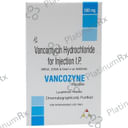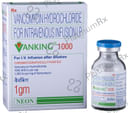Vancomycin
Uses
Vancomycin is used to treat severe bacterial infections.
How it Works
How Vancomycin works Vancomycin is an antibiotic that kills bacteria by inhibiting their ability to form the protective covering (cell wall) necessary for survival.
Side Effects
Common side effects of Vancomycin include breathlessness, vomiting, nausea, decreased potassium levels in the blood, abdominal pain, decreased white blood cell count (neutrophils), phlebitis, hypotension (low blood pressure), flatulence, hearing loss, renal toxicity, headache, fever, peripheral edema, fatigue, urinary tract infection, back pain, and red man syndrome.
Expert Advice
- You have been prescribed Vancomycin to treat serious bacterial infections of the heart, blood, bones, and soft tissues.
- Do not skip any doses and complete the full course of treatment, even if you feel better.
- Stopping the medication early may cause the infection to return and make it harder to treat.
- Vancomycin should be administered slowly via a drip.
- Rapid infusion can lead to reactions such as:
- Low blood pressure
- Wheezing
- Shortness of breath
- Itching
- Your doctor may regularly monitor your kidney function and hearing while you are taking this medication.
- Your doctor may perform regular blood tests to check the level of Vancomycin in your blood.
- Inform your doctor if you are pregnant, planning to conceive, or breastfeeding.
Other Combinations
Ceftriaxone + Vancomycin
Related Medications
Vancomycin 500mg

₹282.1

₹233.4
MRP ₹333.4
Vancomycin 500mg

₹321

₹233.4
MRP ₹333.4
Vancomycin 500mg

₹314

₹233.4
MRP ₹333.4
Vancomycin 500mg

₹319

₹233.4
MRP ₹333.4
Vancomycin 500mg

₹271

₹233.4
MRP ₹333.4
Vancomycin 500mg

₹301

₹233.4
MRP ₹333.4
Vancomycin 500mg

₹381

₹233.4
MRP ₹333.4
Vancomycin 500mg

₹362

₹233.4
MRP ₹333.4
Vancomycin 500mg

₹233.4
MRP ₹333.4
Vancomycin 500mg

₹345

₹233.4
MRP ₹333.4
Vancomycin 500mg

₹300

₹233.4
MRP ₹333.4
Vancomycin 500mg

₹285

₹233.4
MRP ₹333.4
Vancomycin 500mg

₹282

₹233.4
MRP ₹333.4
Vancomycin 500mg

₹489

₹233.4
MRP ₹333.4
Vancomycin 500mg

₹342.9

₹233.4
MRP ₹333.4
Vancomycin 1000mg

₹452

₹271.5
MRP ₹493.6
Vancomycin 1000mg

₹525

₹271.5
MRP ₹493.6
Vancomycin 1000mg

₹580

₹271.5
MRP ₹493.6
Vancomycin 1000mg

₹489

₹271.5
MRP ₹493.6
Vancomycin 1000mg

₹489

₹271.5
MRP ₹493.6
Vancomycin 1000mg

₹489

₹271.5
MRP ₹493.6
Vancomycin 1000mg

₹500

₹271.5
MRP ₹493.6
Vancomycin 1000mg

₹554.2

₹271.5
MRP ₹493.6
Vancomycin 1000mg

₹680

₹271.5
MRP ₹493.6
Vancomycin 1000mg

₹271.5
MRP ₹493.6